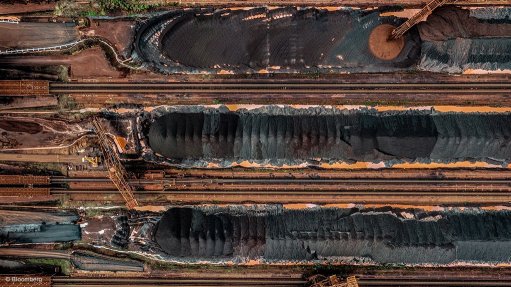US recovery involves short-term pain and long-term gain for commodities
TORONTO (miningweekly.com) – The US economic recovery has placed pressure on metals prices as investors continue to unwind commodities-based positions taken during the resource supercycle, according to Export Development Canada VP and chief economist Peter Hall.
It had not been an orderly event, particularly for commodities-focused nations that experienced pain due to the lower prices, he told an audience at a recent meeting of the Canadian Institute of Mining’s Management and Economic Society in Toronto.
However, the effect was often overdistorted by many exploring the macroeconomic picture. “As the US [recovers] and the dollar goes up, people conclude there’s no confidence anywhere else,” he said. “But we really shouldn’t conclude that.”
SLIMMING THE GLUT
Commodities were favoured during and after the 2008/09 crisis largely because China’s stimulus measures maintained prices across what became the resource supercycle’s final phases.
Now, with the US recovering, speculative positions taken on copper and other metals during that period were being unwound and weighed on commodity prices. Investors now sought value in traditional vehicles.
“Remember how pension funds started getting into copper? Or how we heard Chinese firms and others just kept copper on site because it was appreciating so much during this time?” Hall asked.
Economic revival sped up the process, spurred on by US Fed discussions about tightening quantitative easing measures and then increasing interest rates.
“The moment people believe the global economy is getting back on its feet – and a big signal for that is when the Fed and others start tightening interest rates – then forward pricing is going to start going into reverse,” Hall added.
In the meantime, on the ground, the final phase of the supercycle had spurred overinvestment in extractive projects, producing supply gluts that have weighed on physical uptake and prices.
Technology and unexpected sources of supply compounded matters. As examples, Hall noted that Uganda had become a surprise 600 000 bl/d oil producer, while Brazil now had the ability to exploit vast offshore oil deposits beneath salt shelfs.
“Altogether, it means we have the conundrum whereby the world is trying to recover as it has supply coming out of the ying-yang,” Hall quipped.
WELL-OILED MACHINE
The effect of US recovery and a slump in commodity prices was mirrored in the decline of currencies belonging to countries with large natural resource sectors over the past year.
Even strong trading countries felt pressure as the investment streams flowed back to the US. That included China, which had witnessed a 5.6% drop in its currency.
For net exporters of oil, the pain had been particularly tough, compounded by supply gluts. Compared with 2013 data, lower oil prices in 2015 cost Saudi Arabia $136-billion; Russia $120-billion; and Iraq $50-billion. The cost for Canada had been $25-billion.
But net importers had made important savings compared with 2013. The EU saved $168-billion; the US $143-billion; and China $106-billion. “And in China, $100-billion dollars goes a lot further,” said Hall.
For the US, the $143-billion equated to roughly a 1.4% bonus on consumer spending, Hall noted. “Don’t tell me it’s not going to have a powerful impact on the world’s number-one economy, which also has the most economic linkages with the rest of the world.”
Growth in the US was tangible, he added. The main indicators included increased homebuilding and a decline in unemployment levels.
However, unemployment rates below 5% might raise concern by heralding increases in real wages among the workforce that, in turn, could prove inflationary.
Auto sales, which sunk to nine-million units a year in the post-crash environment, had climbed to between 18-million and 19-million last year. That was another indicator of consumer confidence and, for physical commodities, an important source of demand.
In addition, there was still room for robust sales as the average US vehicle was ten years old. “And that’s a pretty un-American situation the last time I looked,” Hall joked.
THE CHINA FACTOR
The second-largest global economy was facing unique hurdles that also fed into its commodities demand – one of which was the increased cost of labour affecting its manufacturing competitiveness compared with other nations, such as Mexico.
China had also started its move towards greater consumerism. Within this, it needed people to save less and boost consumption as a share of gross domestic product (GDP). Current savings levels stand at 40% to 45% of earnings, Hall noted.
Many commentators had stressed declining GDP growth rates as a warning signal. But Hall stressed they often forgot the compound nature of growth; for example, the increase of 2015 equated to that experienced across 2004 to 2008.
Some also forgot that Chinese stimulus measures had a dual purpose: to embed popular as well as economic stability. The country’s ability to ensure this was achieved could be both quick and staggering in scale.
As examples, Hall stressed how the 2008/09 economic crisis had been near-catastrophic for China. Trade as a share of GDP sunk from 70% to 50% in the immediate aftermath of the crisis, but stimulus quickly ensured this vast gap was covered.
The 2008/09 crisis also crashed the Chinese real estate market, with people protesting as a result. Stimulus resolved that situation too.
It also ensured that mass layoffs were avoided and that the Chinese people remained economically engaged. However, it meant factories and heavy industries kept producing at full rates, building up large inventories that became serious headaches for several sectors.
With less commodity-heavy projects and the tilt towards consumerism, much of that excess supply now looks to markets outside China, which has provoked dumping fears, particularly in Europe and the US.
Steelmaking was a classic example. “Anybody that’s flown over a modern, large steelmaking plant in China would catch their breath and maybe even have a heart attack at what they’d see in terms of inventory,” said Hall. “It’s high-quality stuff too.”
It would take time and discomfort, but the markets would eventually witness the recalibration of commodities' supply-demand ratios. “And that’s the time when we’ll see what true pricing should be,” concluded Hall.
Comments
Press Office
Announcements
What's On
Subscribe to improve your user experience...
Option 1 (equivalent of R125 a month):
Receive a weekly copy of Creamer Media's Engineering News & Mining Weekly magazine
(print copy for those in South Africa and e-magazine for those outside of South Africa)
Receive daily email newsletters
Access to full search results
Access archive of magazine back copies
Access to Projects in Progress
Access to ONE Research Report of your choice in PDF format
Option 2 (equivalent of R375 a month):
All benefits from Option 1
PLUS
Access to Creamer Media's Research Channel Africa for ALL Research Reports, in PDF format, on various industrial and mining sectors
including Electricity; Water; Energy Transition; Hydrogen; Roads, Rail and Ports; Coal; Gold; Platinum; Battery Metals; etc.
Already a subscriber?
Forgotten your password?
Receive weekly copy of Creamer Media's Engineering News & Mining Weekly magazine (print copy for those in South Africa and e-magazine for those outside of South Africa)
➕
Recieve daily email newsletters
➕
Access to full search results
➕
Access archive of magazine back copies
➕
Access to Projects in Progress
➕
Access to ONE Research Report of your choice in PDF format
RESEARCH CHANNEL AFRICA
R4500 (equivalent of R375 a month)
SUBSCRIBEAll benefits from Option 1
➕
Access to Creamer Media's Research Channel Africa for ALL Research Reports on various industrial and mining sectors, in PDF format, including on:
Electricity
➕
Water
➕
Energy Transition
➕
Hydrogen
➕
Roads, Rail and Ports
➕
Coal
➕
Gold
➕
Platinum
➕
Battery Metals
➕
etc.
Receive all benefits from Option 1 or Option 2 delivered to numerous people at your company
➕
Multiple User names and Passwords for simultaneous log-ins
➕
Intranet integration access to all in your organisation





















